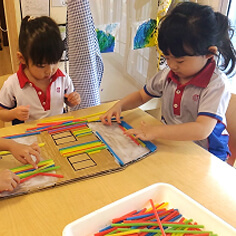The Joys of Outdoor Learning
PCF Sparkletots Preschool @ Pioneer Blk 661
Research has shown that providing children with more outdoor learning opportunities contribute towards their physical development, stronger immune systems and higher levels of attention and well-being. In view of these benefits, PCF Sparkletots Preschool @ Pioneer Blk 661B has created an innovative curriculum which utilises the great outdoors to support children’s holistic learning and development. Principal, Mdm Hamidah, shares more about her centre’s efforts.
LESSONS IN THE BIG OUTDOORS
If you walk past PCF Sparkletots Preschool @ Pioneer Blk 661B, you may catch a glimpse of young children sitting on picnic mats on the field outside their centre. The children are either listening intently to an animated storytelling session or happily painting on DIY easels with music playing in the background. Look closer and you will realise that these children are actually pre-Nursery to N1 children (4 years old and below). Despite their young age, the children are paying close attention to the activities at hand, not at all distracted by the environment around them.
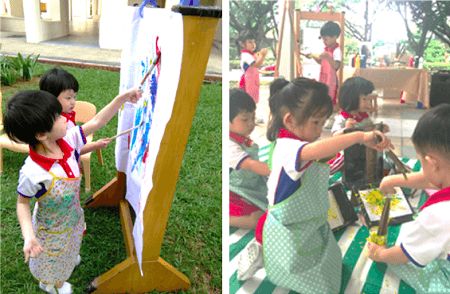
Music & Nature Creative Art – one of the outdoor learning programmes conducted at PCF Sparkletots Preschool @ Pioneer Blk 661B
BENEFITS OF OUTDOOR LEARNING
According to Bento & Dias (2017), by providing opportunities for outdoor play, children benefit from being exposed to sunlight, natural elements, and open air. This in turn contributes to bones development, stronger immune system and physical activity. Physical activity from an early age is important to combat childhood obesity. Bento & Dias (2017) also reported that allowing children to play in green outdoor environments promotes higher levels of attention and well-being. Higher levels of attention would enable them to focus better during lesson time.
Principal, Mdm Hamidah experienced for herself the positive impacts of outdoor learning when she went on a study trip to Perth, Australia. She saw how the Australian children enjoyed and benefited from being immersed in a variety of outdoor learning experiences. She wanted the children from her centre to have the same learning opportunities as well.
Integrating outdoor learning into the preschool curriculum was also part of Mdm Hamidah’s plan to discourage excessive gadget use for young children. She observed that excessive screen-time caused young children to have shortened attention span and become more restless during lesson time.
“We want to help children disconnect from technology and draw on the elements of nature to help them feel calm, relax and achieve mindfulness. Children are able to focus and allow nature to ignite their thoughts and senses, without judging whether they are right or wrong,” shared Mdm Hamidah.
LESSONS IN THE BIG OUTDOORS
Under Mdm Hamidah’s guidance and mentorship, the outdoor learning programme was piloted in 2016 and the centre has been fine-tuning the programme since then. The children get to experience outdoor activities at least three times a week for all levels and the activities are usually conducted in community spaces. During rainy days, the activities are conducted in the nearby multi-purpose hall or void-deck.
There are currently two key outdoor learning programmes for their Pre-Nursery to N1 children. “Story Comes Alive” is a unique storytelling session held outdoors. Early childhood educators dramatize animated stories with the children using puppets, props and musical instruments. This actively engages the children and ignite their imagination. Prior to the actual outdoor lessons, children are encouraged to participate in the creation of props and puppets. This co-creation process gives the children a sense of empowerment and they become more vested in their learning.
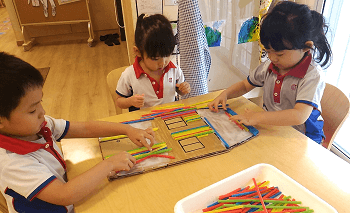 | 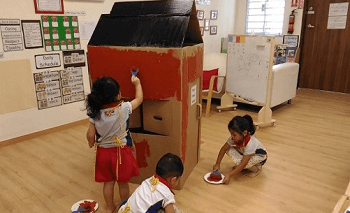 |
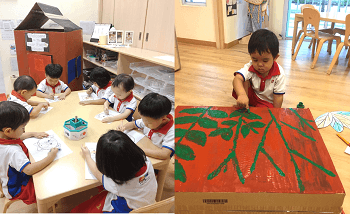
Creating props for “Story Comes Alive”(clockwise) Children creating the straw house for the story ‘Three Little Pigs’; painting the house for the story ‘Goldlilocks and the Three Bears’; painting the box and colouring the headgears for the story ‘Walking Through the Jungle'.
The other programme, “Music & Nature Creative Art”, is a series of art activities conducted with different genres of music playing in the background. Music genres range from classical to hip-hop. Collectively, the environment and music
guide the children’s self-expression as they explore various art techniques and mediums to create unique art pieces. The children also develop fine-motor skills as they learn basic brush strokes. To create their art, the children are encouraged
to use natural elements around them. Lessons about caring for nature are gently reinforced as educators guide the children to use fallen elements that they pick up, instead of injuring the plants and animals they encounter.
BRINGING NATURE INTO THE CLASSROOM
While the unique outdoor learning programmes are conducted with the younger children, the older age children (K1, K2) are not left out. PCF Sparkletots Preschool @ Pioneer Blk 661B has a mini-garden in their backyard growing edible plants such as pandan and herbs. This “edible” garden was set up with the help of parent volunteers. Mdm Hamidah and her educators use this garden to help the children learn about the plant life cycle, uses of different plant parts and basic gardening skills. The children also built their own worm compost bin. As part of their learning, they monitor and record the changes that take place in the compost bin. They also distribute the liquid compost to fertilise the plants in the garden.
 | 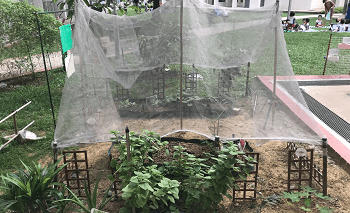 |
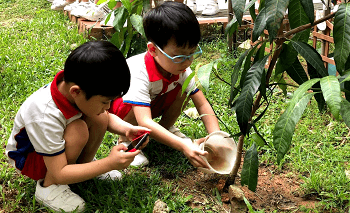 | 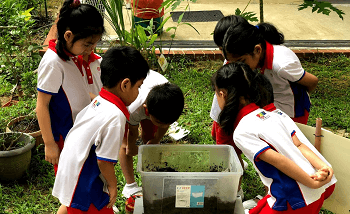 |
The “edible” garden of PCF Sparkletots Preschool @ Pioneer Blk 661B.
The children also harvest the edible plants such as pandan and herbs for use in their cooking class – “Culture through Food”. A mini-kitchen integrated into the classroom enables the children to use the harvested plants as ingredients to create local dishes. Through cooking (and eating), the children gain an appreciation for the food cultural diversity of Singapore.

“Culture through Food” – creating dishes reflective of Singapore’s cultural diversity using plants from the “edible” garden
Mdm Hamidah also makes a conscious effort to bring the outdoors into the classrooms by using natural materials and plants in the décor. Teaching and learning resources also incorporate elements of nature, such as dried leaves, stones and seashells.
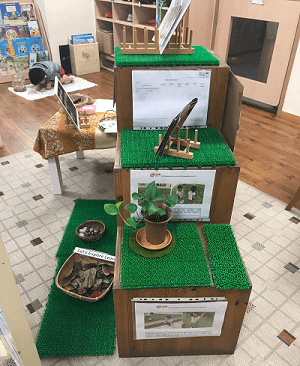
Incorporating greenery and elements of nature into the classroom
STARTING OUTDOORS
Mdm Hamidah believed in starting the children young. She piloted the outdoor learning programme with the Pre-Nursery and Nursery 1 children (4 years old and below). However, at the outset, she received multiple feedback from her educators that the outdoors might be too distracting and too stimulating for the children.
To create a shared vision for her team of educators, Mdm Hamidah involved them in the entire conceptualisation process. She tapped their individual skills and interests (e.g. ability to play the guitar, sing and tell stories) to shape the outdoor learning curriculum. She also encouraged her educators to be resourceful and creative when extending the children’s learning beyond the limits of the classroom. They also had to be aware of the different learning needs of the children.
Together, Mdm Hamidah and her educators devised methods to get the children more engaged and attentive outdoors.
“I tell my educators to think about how they can replicate the engagement levels that tech devices bring to children when they conduct their outdoor programmes. We considered the active animations and movement, changes in tone of voice, incorporation of various types of music – various elements that would interest and attract children to sit through a YouTube video or interactive app – and tweaked our outdoor curriculum to include them,” said Mdm Hamidah.
She elaborated: “For example, during a storytelling session, my educators would become animated and change the tone of their voices to make the various characters come alive. They ask the children questions at important parts of the story. They play instruments and sing along with the children. They incorporate the outdoor environment into their storyline. All these elements keep the children captivated and engaged in the outdoor programme.”

Early childhood educators devise a variety of innovative ways to engage children for “Story Comes Alive”
After conducting the outdoor lessons with her children, Mdm Hamidah observed that the children actually became more attentive and responsive to their educators. The children’s improvement was also extended to indoor lesson time.
OVERCOMING CHALLENGES
Conducting lessons outside of the safe confines of the classroom will always pose challenges. Thankfully, the preschool has the support of PCF HQ and team of early childhood educators in ensuring sufficient manpower when bringing the children outdoors.
Apart from ensuring the children’s safety, the centre ensures they have ample teaching resources and a conducive outdoor setting that is hazard-free, clean and away from excessive loud noises. As they are using shared community spaces, Mdm Hamidah and her educators also had to establish positive relationships with the neighbours to get their support.
However, the greatest challenge was convincing parents to come on board. Parents were concerned about exposing their child to outdoor elements such as mosquitoes and excessive heat. Mdm Hamidah and her educators managed to overcome this through constant communication with parents. They ensured that parents received timely updates, photos and videos of the children’s outdoor learning experiences through a communication mobile application. The parents’ best assurance came from hearing their own children talk about how much they enjoyed their lessons.
FUTURE PLANS
Mdm Hamidah and her team of educators have plans to introduce a new outdoor sports programme, which will focus on children’s motor skills development (MSD).
“Through this programme, we aim to develop the children’s self-esteem, sportsmanship, leadership skills, teamwork, communication skills and the value of respect. Children will apply skills learnt during their MSD lessons in team sports such as football and netball,” explains Mdm Hamidah.
For centres keen to kick-start similar outdoor learning programmes, Mdm Hamidah has the following advice to share: “Start small. Start with one class and conduct it once a term. Once the programme and confidence grow through many rounds of trials and evaluations, it will be easier to provide a sustainable and meaningful programme.”
All photographs and videos were contributed by PCF Sparkletots Preschool @ Pioneer Blk 661B.
.png?sfvrsn=5bbfd6df_1)
